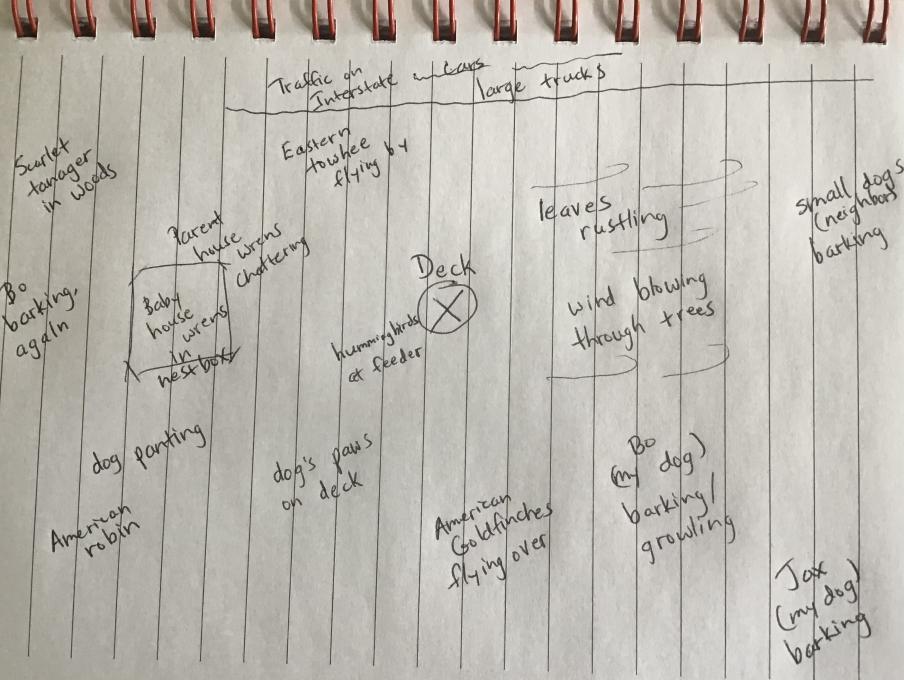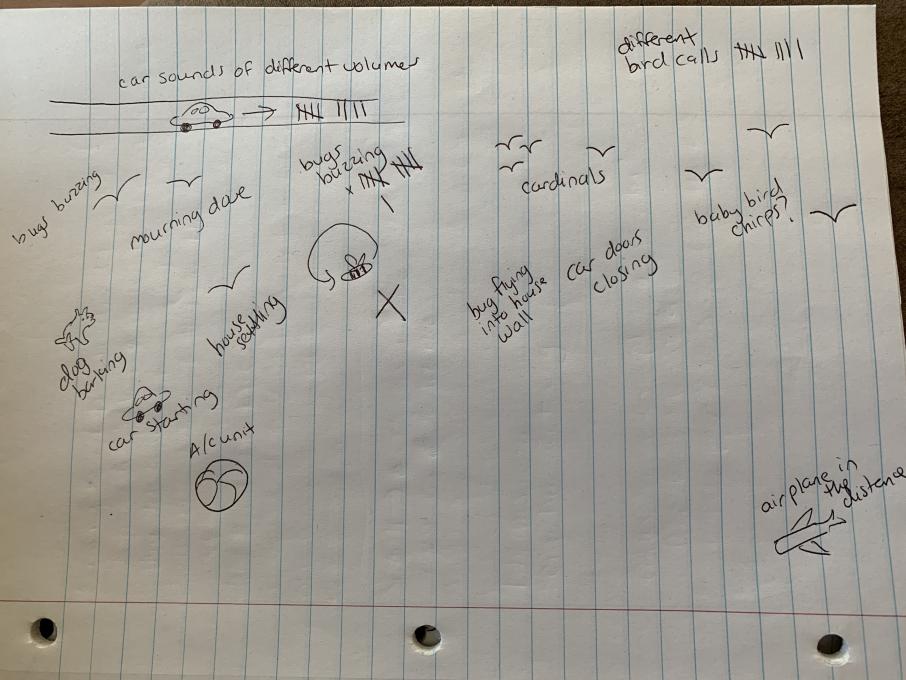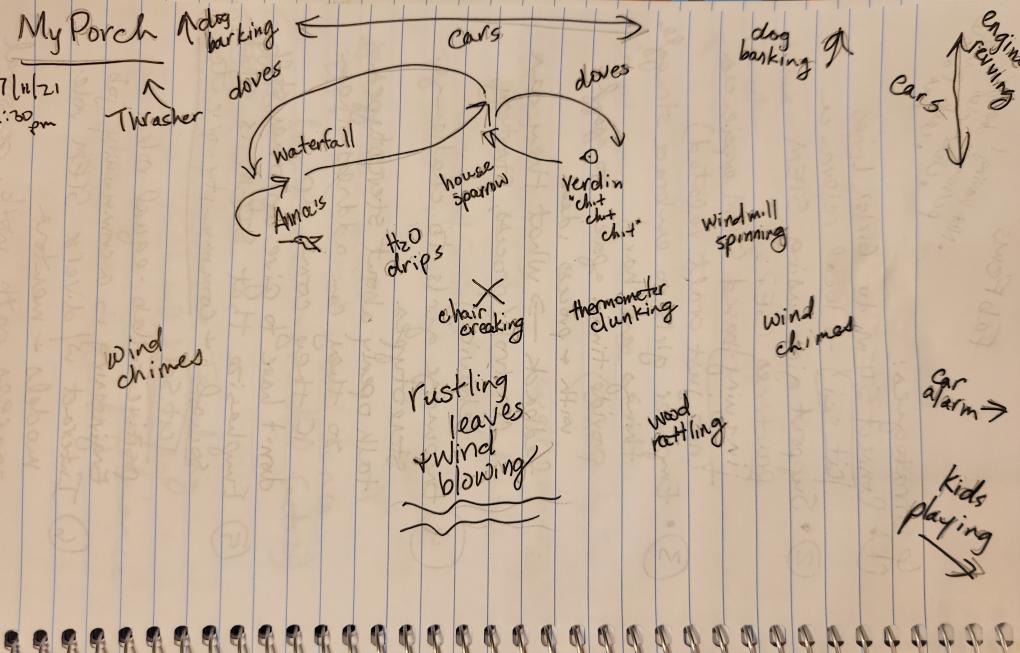The Cornell Lab Bird Academy › Discussion Groups › Virtual Educator Retreat: Inspiring Investigations through Citizen Science › Virtual Educator Retreat: Encouraging Observations
-
The time of day has an impact on what gets recorded on the sound map. Since I chose the middle of the day, I didn’t have nearly the number of bird calls than if I had gone out much earlier in the morning. I think it would be interesting to compare students’ sound maps from different class periods. I am always telling students to look up at the sky and observe what is going on instead of having their faces buried in their phones or other technological devices. As with developing any skill it takes practice and repetition for students to learn how to pay attention to the world around them and make good observations. Slowing down is good practice for everyone.

-
What a great idea to compare class periods! I had the thought of doing this activity once in the fall and then again in the spring and compare the two seasons.
-
-
Like others have said, the most impactful thing is slowing down and focusing on what happens around us. We humans are normally very focused on what is going on with ourselves at a given time and it is easy to overlook what's happening in the natural world right outside our windows. I was familiar with the sound map activity prior to this course, and I did it with my students last year. I introduced the activity by reminding them that we focus so much on the things we can see when making observations that we forget our sense of hearing is an observation tool, and we can learn a lot just by listening. I encouraged them to use tally marks if they think they are hearing the same bird calling more than once, or make space to tally how many different types of bird calls they think they hear in our given time. I teach 7th grade, and I found that asking them to be silent while in a large group setting outside with their peers (25ish kids) is a challenge for them, even if they are spread out from each other. Because of that, I kept the "silent time" to no more than 3 minutes. I asked them not to intentionally try to make sounds during our observation time (no twig snapping, leaf crunching, etc.), that we wanted to hear what the birds, squirrels, and other animals living in that space would hear if we were not there. They were really good at respecting that ask, I was proud of them. :) I found that modeling this activity is SO important for them. Many had a hard time understanding that they are the "X" and how that relates to where they should try to put their sketches/words. I took a dry erase board outside with us and used that to demonstrate the activity. I think this really helped them not focus so much on "Am I doing this right?" and just enjoy the experience. When I do this again, I'd like to incorporate more reflection. Perhaps I will have them spend a few minutes studying their sound map and come up with a couple questions about what they heard.

-
 I think the most impactful thing for me was just the reminder to slow down and take the time to listen. There are so many noises that I take for granted and never focus on. I realized that I was paying closer attention to specific things related to the sounds - for example, the speed of the water dripping as it sped up and slowed down - not something I would normally notice. It was easy to catch the bigger noises at first, but as I continued to listen I heard more of the subtle, little ones. With kids, I would really encourage them to close their eyes as they listen. I would also talk about how there's no wrong way to do this. If they don't know what a sound is, they can just write what it sounds like or just make a symbol on the paper.
I think the most impactful thing for me was just the reminder to slow down and take the time to listen. There are so many noises that I take for granted and never focus on. I realized that I was paying closer attention to specific things related to the sounds - for example, the speed of the water dripping as it sped up and slowed down - not something I would normally notice. It was easy to catch the bigger noises at first, but as I continued to listen I heard more of the subtle, little ones. With kids, I would really encourage them to close their eyes as they listen. I would also talk about how there's no wrong way to do this. If they don't know what a sound is, they can just write what it sounds like or just make a symbol on the paper. -
 I thought the most impactful thing about creating my sound map was that I wasn't just sitting around outside; I had a mission to listen. It was awesome! It was also fun to record the sound observations with images and symbols and words.
I thought the most impactful thing about creating my sound map was that I wasn't just sitting around outside; I had a mission to listen. It was awesome! It was also fun to record the sound observations with images and symbols and words. -
I like your drawings!
-
@Pam Thank you.
-
-
 The most impactful thing I discovered is how freeing it is to jot down scribbles instead of words that name what you hear. It is much easier to focus on just listening. I was able to quickly decide to mark down what I heard and not be concerned with marking down every bird chirp that came from the same place.
Having students make a sound map would be another way to gather data about our campus environment. Drawing a sound map with the eyes closed helps to differentiate between different noises that are happening at the same time. This practice helps students listen to objects coming closer or moving further away.
The most impactful thing I discovered is how freeing it is to jot down scribbles instead of words that name what you hear. It is much easier to focus on just listening. I was able to quickly decide to mark down what I heard and not be concerned with marking down every bird chirp that came from the same place.
Having students make a sound map would be another way to gather data about our campus environment. Drawing a sound map with the eyes closed helps to differentiate between different noises that are happening at the same time. This practice helps students listen to objects coming closer or moving further away.
Read More:


 I think the most impactful thing for me was just the reminder to slow down and take the time to listen. There are so many noises that I take for granted and never focus on. I realized that I was paying closer attention to specific things related to the sounds - for example, the speed of the water dripping as it sped up and slowed down - not something I would normally notice. It was easy to catch the bigger noises at first, but as I continued to listen I heard more of the subtle, little ones. With kids, I would really encourage them to close their eyes as they listen. I would also talk about how there's no wrong way to do this. If they don't know what a sound is, they can just write what it sounds like or just make a symbol on the paper.
I think the most impactful thing for me was just the reminder to slow down and take the time to listen. There are so many noises that I take for granted and never focus on. I realized that I was paying closer attention to specific things related to the sounds - for example, the speed of the water dripping as it sped up and slowed down - not something I would normally notice. It was easy to catch the bigger noises at first, but as I continued to listen I heard more of the subtle, little ones. With kids, I would really encourage them to close their eyes as they listen. I would also talk about how there's no wrong way to do this. If they don't know what a sound is, they can just write what it sounds like or just make a symbol on the paper.  I thought the most impactful thing about creating my sound map was that I wasn't just sitting around outside; I had a mission to listen. It was awesome! It was also fun to record the sound observations with images and symbols and words.
I thought the most impactful thing about creating my sound map was that I wasn't just sitting around outside; I had a mission to listen. It was awesome! It was also fun to record the sound observations with images and symbols and words.  The most impactful thing I discovered is how freeing it is to jot down scribbles instead of words that name what you hear. It is much easier to focus on just listening. I was able to quickly decide to mark down what I heard and not be concerned with marking down every bird chirp that came from the same place.
Having students make a sound map would be another way to gather data about our campus environment. Drawing a sound map with the eyes closed helps to differentiate between different noises that are happening at the same time. This practice helps students listen to objects coming closer or moving further away.
The most impactful thing I discovered is how freeing it is to jot down scribbles instead of words that name what you hear. It is much easier to focus on just listening. I was able to quickly decide to mark down what I heard and not be concerned with marking down every bird chirp that came from the same place.
Having students make a sound map would be another way to gather data about our campus environment. Drawing a sound map with the eyes closed helps to differentiate between different noises that are happening at the same time. This practice helps students listen to objects coming closer or moving further away.